Tongue–Computer Interface Prototype Design Based on T-Type Magnet Localization for Smart Environment Control
Abstract
:1. Introduction
- ■
- Section 2 presents the inverse magnetic localization model based on the combined T-type PM and sensor array measurements, the constitution of the aLMA, and a comprehensive sensing system calibration method;
- ■
- Section 3 describes the architecture of the prototype system, including the hardware and the custom-made graphical user interface (GUI);
- ■
2. Methodology
2.1. System Architecture
2.2. Inverse Magnetic Localization Based on Adaptive LM Algorithm
2.2.1. Inverse Model
2.2.2. Adaptive LM Algorithm
- In Step 1, initializations derived from real-time measurements are figured out to reduce the searching region. From Equation (1), we can find that the magnetic fields attenuate rapidly with the distance between the sensor and the PM. Since the sensor array is distributed along the mouth contour in our study, we take rp0 = (xp (Bm_max),0, zp (Bm_max)) and M0 = (0, 0), where xp (Bm_max) and zp (Bm_max) are the xz-plane location of the sensor with the strongest measurement.
- A pre-estimated result can be given by solving the inverse magnetic problem in Equation (3) with the LM algorithm using the initializations above, which provides initializations of the magnetic dipole with improved reliability, which is termed the first-stage LM algorithm.
- With the pre-estimated result from the first stage LM algorithm as initializations, the inverse problem in Equation (3) is solved in the second-stage LM algorithm, from which the final localization result is determined.
2.3. Comprehensive Sensing System Calibration
- Dipole moment calibration: to figure out the moment magnitude (mv, mh) and the deviation (φmv, θmv, φmh, θmh) of the unit moment from the cylindrical PM axis during magnetization.
- Sensing axis calibration: to determine the rotational matrix Ri between the ith local sensor frame {Si} and Cartesian coordinate.
2.3.1. PM Calibration
2.3.2. Sensor Calibration
3. Simulated Intraoral Magnetic Localization Setup
4. Experimental Results and Discussions
4.1. Performance of Sensing System Calibration
4.2. Magnetic Localization Evaluation
4.2.1. Magnetic Fields Derived from the T-Type PM
4.2.2. Localization Performance
5. Conclusions
Author Contributions
Funding
Conflicts of Interest
References
- Zhang, B.; Luo, Y.; Ma, L.; Gao, L.; Li, Y.; Xue, Q.; Yang, H.; Cui, Z. 3D bioprinting: An emerging technology full of opportunities and challenges. Bio-Des. Manuf. 2018, 1, 2–13. [Google Scholar] [CrossRef]
- Yang, Y.; Li, Y.; Chen, Y. Principles and methods for stiffness modulation in soft robot design and development. Bio-Des. Manuf. 2018, 1, 14–25. [Google Scholar] [CrossRef] [Green Version]
- Rashid, Z.; Melià-Seguí, J.; Pous, R.; Peig, E. Using augmented reality and internet of things to improve accessibility of people with motor disabilities in the context of smart cities. Future Gener. Comput. Syst. 2016, 76, 248–261. [Google Scholar] [CrossRef]
- Jafari, A.; Buswell, N.; Ghovanloo, M.; Mohsenin, T. A low-power wearable stand-alone tongue drive system for people with severe disabilities. IEEE Trans. Biomed. Circuits Syst. 2018, 12, 58–67. [Google Scholar] [CrossRef] [PubMed]
- Anaelis, S.; Malek, A.; Mercedes, C.; Melvin, A.; Armando, B. Adaptive eye-gaze tracking using neural-network-based user profiles to assist people with motor disability. J. Rehabil. Res. Dev. 2008, 45, 801–817. [Google Scholar] [CrossRef]
- Postelnicu, C.C.; Girbacia, F.; Talaba, D. EOG-based visual navigation interface development. Expert Syst. Appl. 2012, 39, 10857–10866. [Google Scholar] [CrossRef]
- Williams, M.R.; Kirsch, R.F. Evaluation of head orientation and neck muscle EMG signals as command inputs to a human–computer interface for individuals with high tetraplegia. IEEE Trans. Neural Syst. Rehabil. Eng. 2008, 16, 485–496. [Google Scholar] [CrossRef]
- Paul, G.M.; Cao, F.; Torah, R.; Yang, K.; Beeby, S. A smart textile based facial EMG and EOG computer interface. IEEE Sens. J. 2014, 14, 393–400. [Google Scholar] [CrossRef]
- Fukuma, R.; Yanagisawa, T.; Saitoh, Y.; Hosomi, K.; Kishima, H.; Shimizu, T.; Sugata, H.; Yokoi, H.; Hirata, M.; Kamitani, Y.; et al. Real-Time Control of a Neuroprosthetic Hand by Magnetoencephalographic Signals from Paralysed Patients. Sci. Rep. 2016, 6, 21781. [Google Scholar] [CrossRef]
- Hochberg, L.R.; Bacher, D.; Jarosiewicz, B.; Masse, N.Y.; Simeral, J.D.; Vogel, J.; Haddadin, S.; Liu, J.; Cash, S.S.; van der Smagt, P.; et al. Reach and grasp by people with tetraplegia using a neurally controlled robotic arm. Nature 2012, 485, 372–375. [Google Scholar] [CrossRef] [Green Version]
- Carabez, E.; Sugi, M.; Nambu, I.; Wada, Y. Identifying single trial event-related potentials in an earphone-based auditory brain-computer interface. Appl. Sci. 2017, 7, 1197. [Google Scholar] [CrossRef]
- Shen, H.M.; Hu, L.; Lee, K.M.; Fu, X. Multi-motion robots control based on bioelectric signals from single-channel dry electrode. Proc. Inst. Mech. Eng. H 2015, 229, 124–136. [Google Scholar] [CrossRef] [PubMed]
- Caltenco, H.A.; Breidegard, B.; Struijk, L.N. On the tip of the tongue: Learning typing and pointing with an intra-oral computer interface. Disabil. Rehabil. Assist. Technol. 2014, 9, 307–317. [Google Scholar] [CrossRef] [PubMed]
- Nakatani, S.; Araki, N.; Konishi, Y. Tongue-motion classification using intraoral electromyography for a tongue-computer interface. In Proceedings of the IEEE International Conference on Systems Man and Cybernetics Conference Proceedings, City University of Hong Kong, Hong Kong, China, 9–12 October 2015; pp. 2349–2353. [Google Scholar]
- Takahashi, J.; Suezawa, S.; Hasegawa, Y.; Sankai, Y. Tongue motion-based operation of support system for paralyzed patients. In Proceedings of the IEEE International Conference on Rehabilitation Robotics, ETH Zurich, Zurich, Switzerland, 27 June–1 July 2011. [Google Scholar]
- Choi, C.; Micera, S.; Carpaneto, J.; Kim, J. Development and quantitative performance evaluation of a noninvasive EMG computer interface. IEEE Trans. Bio-Med. Eng. 2009, 56, 188–191. [Google Scholar] [CrossRef] [PubMed]
- Vaidyanathan, R.; Chung, B.; Gupta, L.; Kook, H.; Kota, S.; West, J.D. Tongue-movement communication and control concept for hands-free human–machine interfaces. IEEE Trans. Syst. Man Cybern. Part A Syst. Hum. 2007, 37, 533–546. [Google Scholar] [CrossRef]
- Mamun, K.A.; Mace, M.; Gupta, L.; Verschuur, C.A.; Lutman, M.E.; Stokes, M.; Vaidyanathan, R.; Wang, S.Y. Robust real-time identification of tongue movement commands from interferences. Neurocomputing 2011, 80, 83–92. [Google Scholar] [CrossRef]
- Nam, Y.; Koo, B.; Cichocki, A.; Choi, S. Glossokinetic potentials for a tongue-machine interface: How can we trace tongue movements with electrodes? Syst. Man Cybern. Mag. 2016, 2. [Google Scholar] [CrossRef]
- Rakibet, O.O.; Horne, R.J.; Kelly, S.W.; Batchelor, J.C. Passive wireless tags for tongue controlled assistive technology interfaces. Healthc. Technol. Lett. 2016, 3. [Google Scholar] [CrossRef]
- Struijk, L.N.S.A.; Bentsen, B.; Gaihede, M.; Lontis, E.R. Error-free text typing performance of an inductive intra-oral tongue computer interface for severely disabled individuals. IEEE Trans. Neural Syst. Rehabil. Eng. 2017, 25, 2094–2104. [Google Scholar] [CrossRef]
- Huo, X.; Park, H.; Kim, J.; Ghovanloo, M. A dual-mode human computer interface combining speech and tongue motion for people with severe disabilities. IEEE Trans. Neural Syst. Rehabil. Eng. 2013, 21, 979–991. [Google Scholar] [CrossRef]
- Shen, H.M.; Hu, L.; Qin, L.H.; Fu, X. Real-time orientation-invariant magnetic localization and sensor calibration based on closed-form models. IEEE Magn. Lett. 2015, 6, 1–4. [Google Scholar] [CrossRef]
- Park, H.; Ghovanloo, M. An arch-shaped intraoral tongue drive system with built-in tongue-computer interfacing SoC. Sensors 2014, 14, 21565–21587. [Google Scholar] [CrossRef] [PubMed]
- Huo, X.; Johnson-Long, A.N.; Ghovanloo, M.; Shinohara, M. Motor performance of tongue with a computer-integrated system under different levels of background physical exertion. Ergonomics 2013, 56, 1733–1744. [Google Scholar] [CrossRef] [PubMed] [Green Version]
- Huo, X.L.; Wang, J.; Ghovanloo, M. A Magneto-Inductive Sensor Based Wireless Tongue-Computer Interface. IEEE Trans. Bio-Med. Eng. 2008, 16, 497–504. [Google Scholar] [CrossRef] [Green Version]
- Huo, X.L.; Ghovanloo, M. Evaluation of a wireless wearable tongue–computer interface by individuals with high-level spinal cord injuries. J. Neural Eng. 2010, 7. [Google Scholar] [CrossRef] [PubMed]
- Kim, J.; Park, H.; Bruce, J.; Rowles, D.; Holbrook, J.; Nardone, B. Assessment of the tongue-drive system using a computer, a smartphone, and a powered-wheelchair by people with tetraplegia. IEEE Trans. Neural Syst. Rehabil. Eng. 2016, 24, 68–78. [Google Scholar] [CrossRef] [PubMed]
- Huo, X.L.; Ghovanloo, M. Using Unconstrained Tongue Motion as an Alternative Control Mechanism for Wheeled Mobility. IEEE Trans. Bio-Med. Eng. 2009, 56, 1719–1726. [Google Scholar] [CrossRef]
- Farajidavar, A.; Block, J.M.; Ghovanloo, M. A comprehensive method for magnetic sensor calibration: A precise system for 3-D tracking of the tongue movements. Conf. Proc. IEEE Eng. Med. Biol. Soc. 2012, 4, 1153–1156. [Google Scholar] [CrossRef]
- Hu, C.; Meng, M.Q.H.; Mandal, M. A linear algorithm for tracing magnet position and orientation by using three-axis magnetic sensors. IEEE Trans. Magn. 2007, 43, 4096–4101. [Google Scholar] [CrossRef]
- Song, S.; Li, B.; Qiao, W.; Hu, C.; Ren, H.; Yu, H.; Zhang, Q.; Meng, M.Q.H.; Xu, G. 6-D magnetic and orientation method for an annular magnet based on a closed-form analytical model. IEEE Trans. Magn. 2014, 50, 5000411. [Google Scholar] [CrossRef]
- Lim, J.; Lee, K.M. Distributed multilevel current models for design analysis of electromagnetic actuators. IEEE-ASME Trans. Mech. 2015, 20, 2413–2424. [Google Scholar] [CrossRef]
- Ranganathan, A. The Levenberg-Marquardt Algorithm; Honda Research Institute: Mountain View, CA, USA, 2004. [Google Scholar]


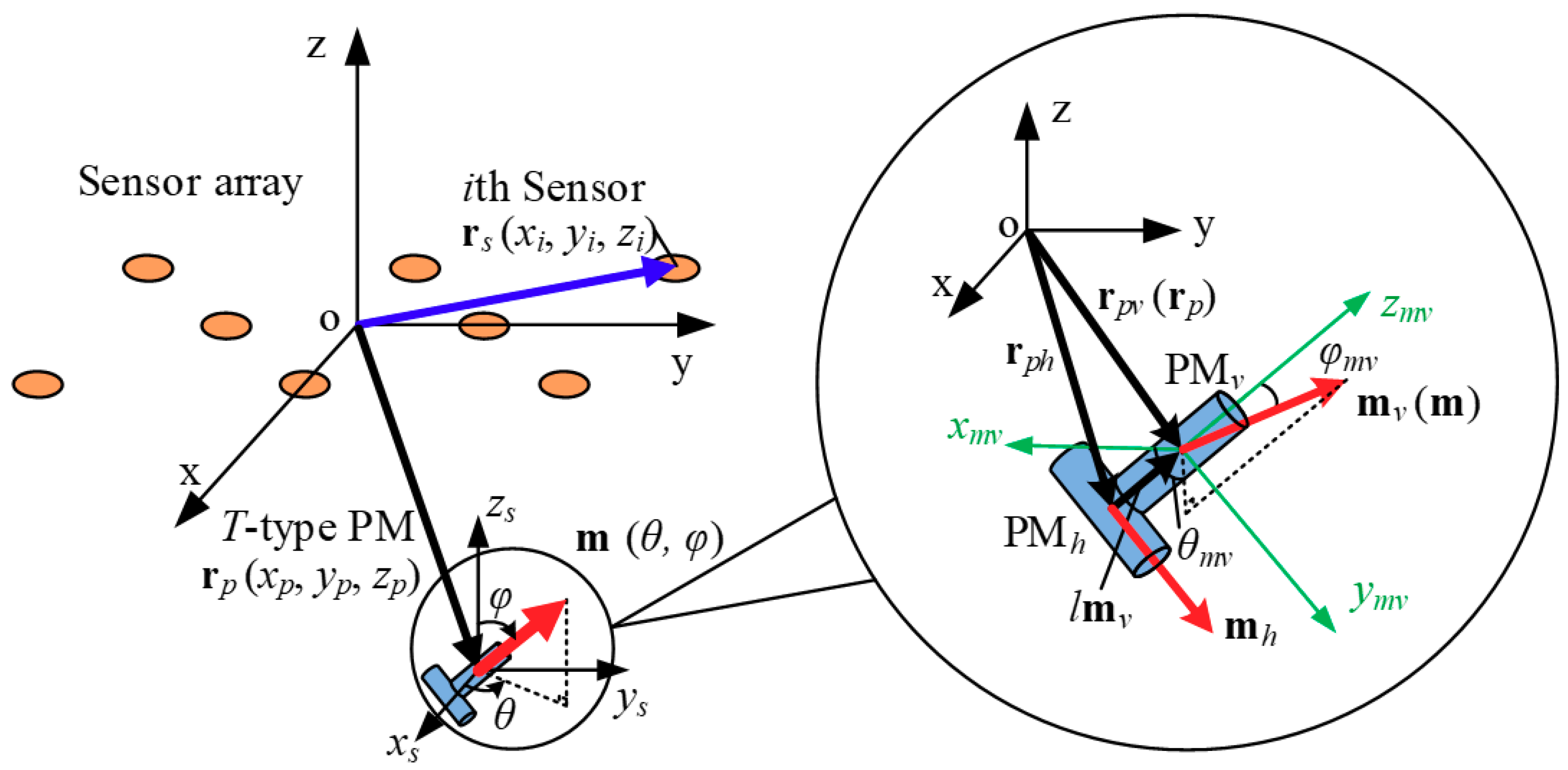


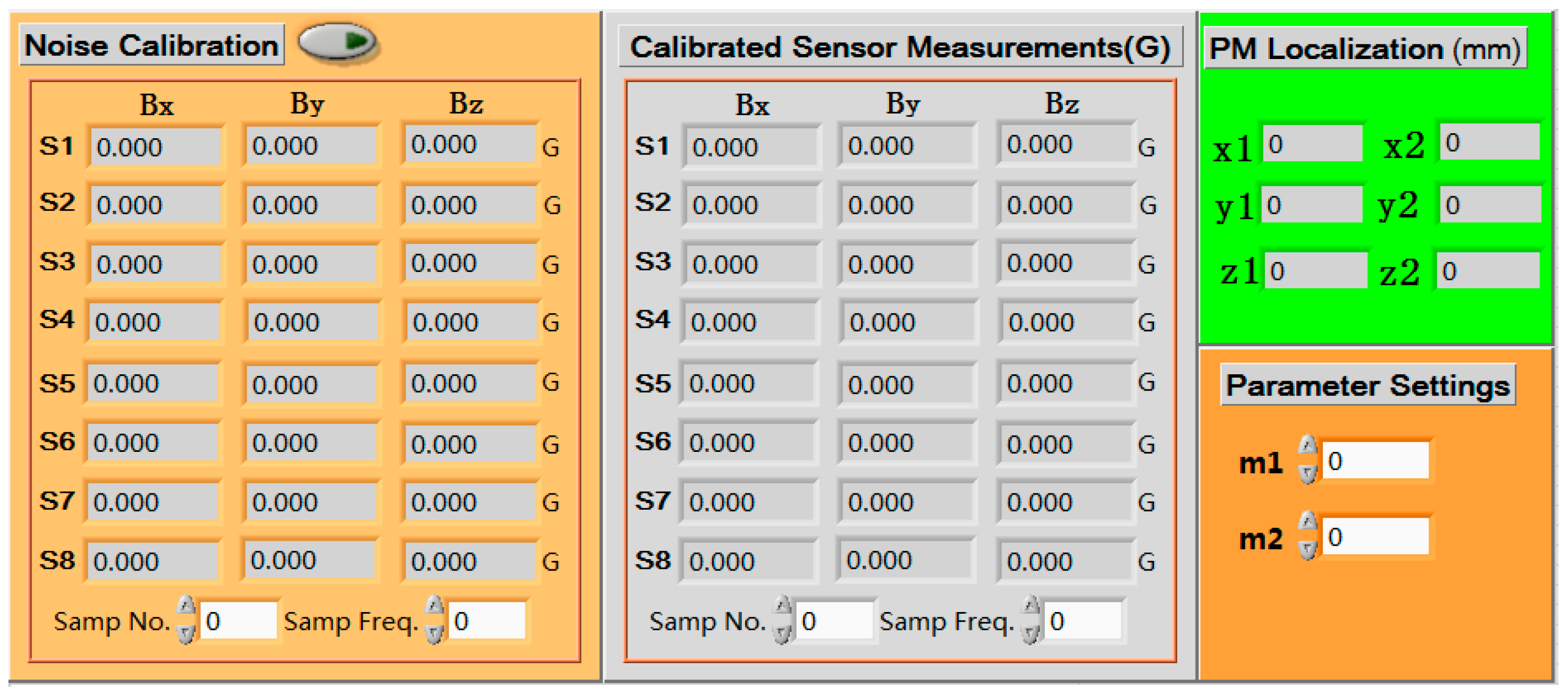
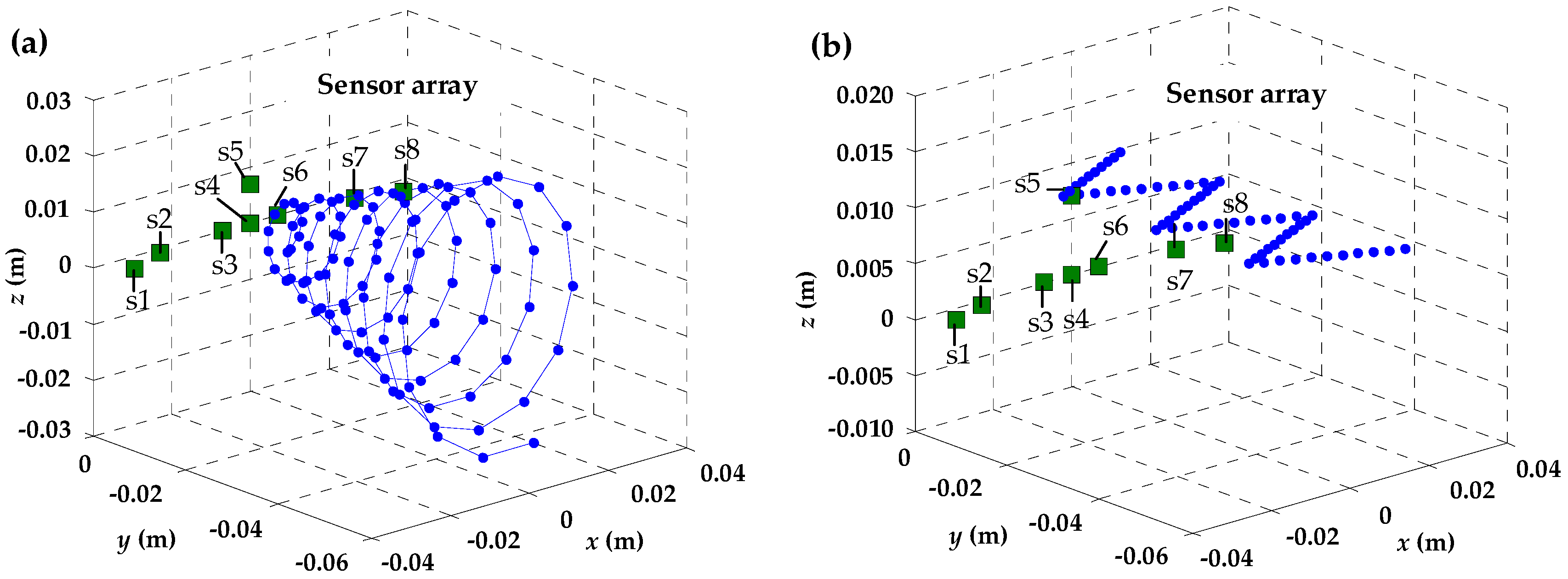
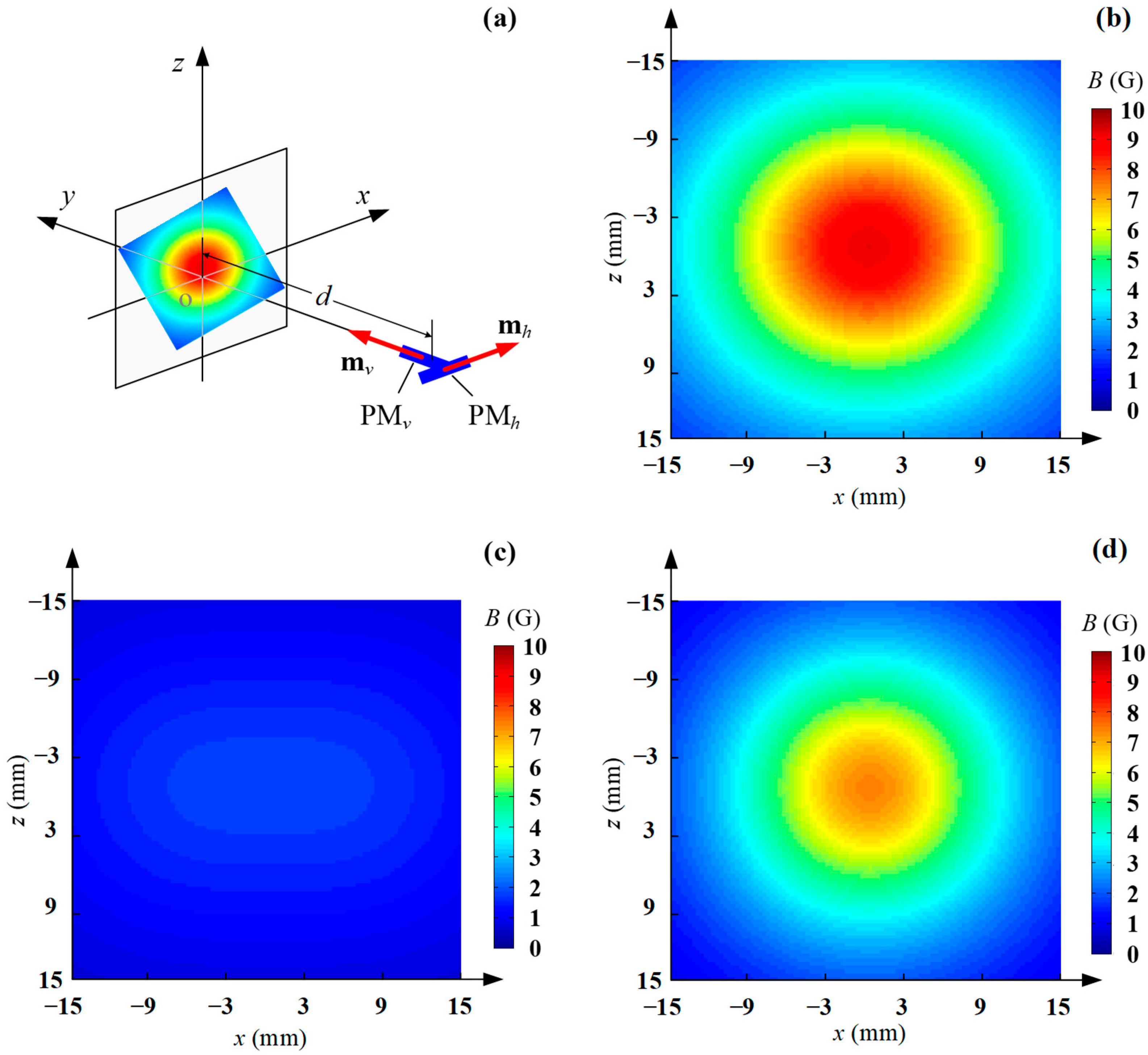
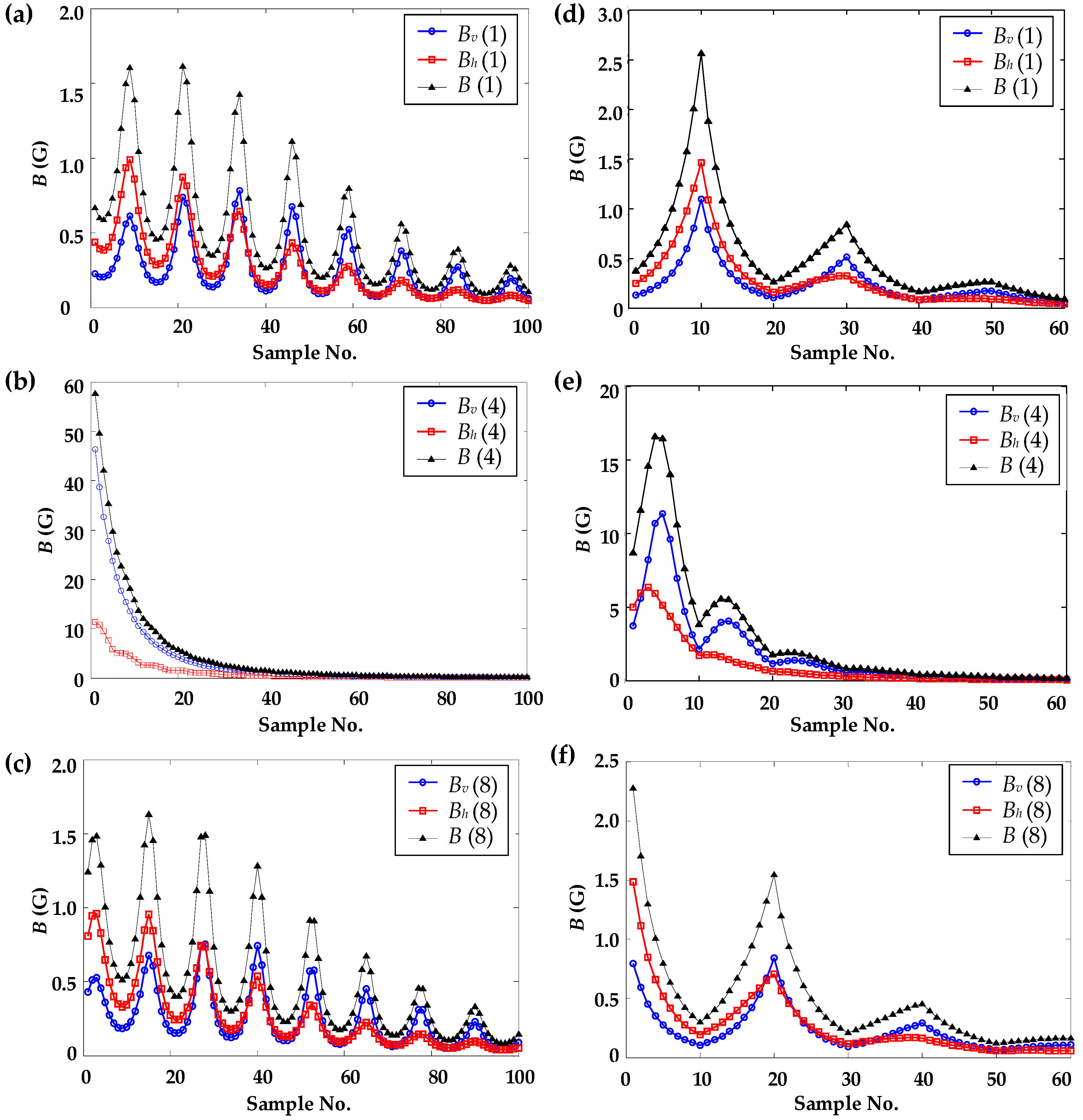

| Components | Property | Manufacture |
|---|---|---|
| T-type PM | Two NdFe-B magnet; Axially magnetized; Φ = 1.56 mm, 2l = 6.48 mm; Br = 0.1430 T | MISUMI, Tokyo, Japan |
| AMR sensor | Eight three-axis HMC5983; Resolution: 0.227 μT; Maximum output rate: 220 Hz Range: ±0.4 mT | Honeywell, Plymouth, MN, USA |
| I2C–USB adapter | VTG200A; 12-bit; | Viewtool, Shenzhen, China |
| Gauss meter | Model-421; resolution: 0.1 μT | Lakeshore, Westerville, OH, USA |
| 3D translation platform | Resolution: 10 μm | MITSUBISHI, Tokyo, Japan |
| m (A·m2) | (φm, θm) (°) | e|B| (%) at P(0, 0, 0.025) (m) | |
| PMv | 0.0125 ± 0.0001 | (1.71, 74.18) | 0.33 |
| PMh | 0.0123 ± 0.0005 | (0.97, 137.53) | 0.21 |
| tLMA | ttLMA | aLMA | |
|---|---|---|---|
| T (ms) | 62.3 | 85.2 | 71.2 |
| e (mm) | 2.4 | 1.7 | 1.1 |
| tLMA | ttLMA | aLMA | |
|---|---|---|---|
| T (ms) | 38.0 | 66.2 | 60.2 |
| e (mm) | 3.5 | 2.8 | 2.2 |
© 2018 by the authors. Licensee MDPI, Basel, Switzerland. This article is an open access article distributed under the terms and conditions of the Creative Commons Attribution (CC BY) license (http://creativecommons.org/licenses/by/4.0/).
Share and Cite
Shen, H.-M.; Yue, Y.; Lian, C.; Ge, D.; Yang, G. Tongue–Computer Interface Prototype Design Based on T-Type Magnet Localization for Smart Environment Control. Appl. Sci. 2018, 8, 2498. https://doi.org/10.3390/app8122498
Shen H-M, Yue Y, Lian C, Ge D, Yang G. Tongue–Computer Interface Prototype Design Based on T-Type Magnet Localization for Smart Environment Control. Applied Sciences. 2018; 8(12):2498. https://doi.org/10.3390/app8122498
Chicago/Turabian StyleShen, Hui-Min, Yang Yue, Chong Lian, Di Ge, and Geng Yang. 2018. "Tongue–Computer Interface Prototype Design Based on T-Type Magnet Localization for Smart Environment Control" Applied Sciences 8, no. 12: 2498. https://doi.org/10.3390/app8122498





